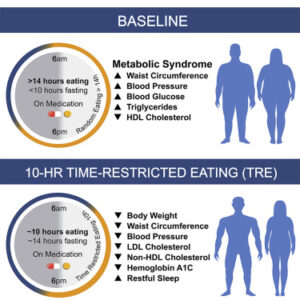Benefits of Time-Restricted Eating
We live in a country where we have access to an overabundance of food 24/7. Most of us have fully stocked pantries, freezers, and fridges to access whatever kind of food we want whenever we want it. As if that’s not enough, as soon as we leave home, we drive by a plethora of eating establishments where we can buy a couple thousand calories for a couple bucks in less than 5 minutes. And in the unlikely event we still get hungry, every retailer in America keeps an ample supply of king-size candy bars in the check-out lane for those moments when we need a 400-calorie boost.
Our bodies were not designed to function well in the land of all-you-can-eat. In fact, our bodies work best when deprived of food on a regular basis.
Our ancestors lived in a world where they often spent hours in the morning looking for food before they could find anything to eat. Sometimes they only ate once a day. Sometimes they didn’t eat at all. Our bodies are designed to function well in those conditions. Believe it or not, you can easily recreate those conditions without disrupting your life too much.

Time-Restricted Eating is a form of daily fasting where you limit your time for eating. It involves eating during an 8-to-12-hour window and fasting during the remaining 12 to 16 hours. This, of course, differs from what most of us do—eat from the time we wake up until the time we go to bed.
Unlike intermittent fasting, which involves calorie restriction, time-restricted eating allows you to eat as much as you want (or normally would) during your 8- to 12-hour eating window.
Time-restricted eating aligns food consumption and fasting cycles to your body’s innate 24-hour circadian rhythm. This is important because many aspects of your physiology and behavior are organized around a daily rhythm driven by an internal circadian clock. More importantly genes involved in the metabolism of carbohydrates and fats function on a circadian rhythm.
Researchers have shown that time-restricted eating produces numerous health benefits, including weight loss, reduced body fat, improved heart function, and enhanced aerobic capacity. All these benefits occurred without any change in types or amounts of foods being eaten (they had their cake and ate it too…and still lost weight).
The master clock that determines your circadian rhythm (the suprachiasmatic nucleus) is in your brain within the hypothalamus. Light is the primary signal that drives the master clock. Your body also has peripheral clocks found in your liver, pancreas, muscles, and fatty tissues. Food intake is the dominant signal in the peripheral clocks. Circulating nutrients from your diet can desynchronize the peripheral clocks from the central clock in your hypothalamus.
A study that looked at the glycemic response to the same meal at different times of the day found that blood glucose after a meal was lowest in the morning and highest in the evening. So, eating a meal late at night will have a more detrimental effect on your blood sugar than eating the same meal in the morning. This increased glucose at bedtime will create a hormonal response that interrupts good sleep.
Eating three standardized meals in a 6-hour window decreased appetite and increased fat metabolism when compared to eating the same three meals in a 12-hour window. A study compared an early time-restricted eating schedule (8 am to 2 pm) and a control schedule (8 am to 8 pm) for four days. Participants who followed the 6-hour eating schedule had lower levels of ghrelin (the hunger hormone) and felt fuller.

Several recent studies have demonstrated the potential of time-restricted eating for preventing or reversing metabolic diseases. When patients with metabolic syndrome adhered to a 10-hour eating window for 12 weeks, they reduced their weight, reduced their blood pressure, and improved their lipid profiles. The participants in the study also decreased their calories by 9 percent despite no recommendations to change the amounts or types of foods they ate.
Animal studies have also shown that time-restricted eating will improve metabolic health. Mice that were fed high-sugar/high-fat diets in a 10-hour eating window improved glucose tolerance, insulin resistance, and cholesterol. They also reduced their body fat even though they ate foods that should have made them fat. The effects were maintained even when the researchers disrupted time-restricted feeding by allowing unrestricted feeding on the weekends.
Research has also shown that time-restricted eating in rodents reverses the progression of type 2 diabetes and obesity.
As you can see, researchers have found strong evidence for the health benefits of time-restricted eating. I could list many more studies, but I feel like the ones listed above make a pretty good case.
To experience the benefits of time-restricted eating for yourself, begin with a 12-hour eating window. If you follow our Simple 9© nutritional program, you already know that you should stop eating three hours before bedtime. If you have your first meal at 7:00 am and your last bite of food at 7:00 pm, you will be off to a great start.
If you can push yourself back to an 11-hour window, you’ll experience even greater results and you’ll move yourself closer to a true circadian rhythm. I use the Zero app to help me stay within an 11-hour window most days.
Remember, everyone’s body responds differently. You might see great results from a 12-hour feeding window, while someone else might do best with a 9-hour window. The 11-hour window seems to work best for me.
Give it a try. Stop eating after 7:00 pm. Brush your teeth as a cue to stop eating. Then don’t eat anything else until breakfast at 7:00 am. If you don’t feel better and sleep better after a week, try an 11- or 10-hour eating window.
Stay Strong,
Bo Railey

